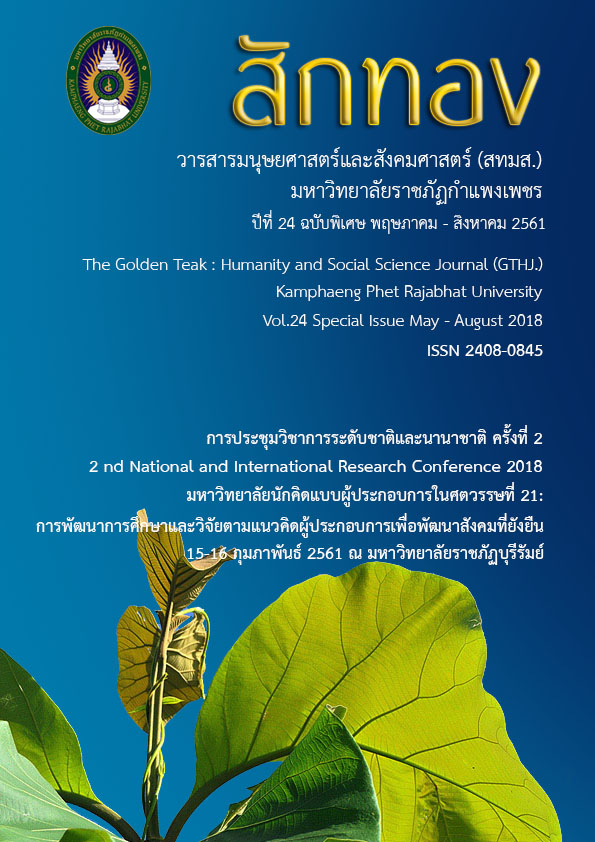The Development of an English Instructional Model Based on “Teaching by Not Teaching” Approach to Enhance the Ability of Reading Comprehension of GRADE 11 Students
Main Article Content
Abstract
The objectives of this research were: 1. to develop an English instructional model based on “Teaching by Not Teaching” Approach to Enhance the Ability of Reading Comprehension of grade 11 students, and 2. to evaluate the effectiveness of the developed instructional model. The samples were 2 classes: an experimental group and a controlled group learned in the course of an English for Everyday Use in the second semester academic year 2017. Research instruments included lesson plans, an English Reading Comprehension test, an observation form, and a student satisfaction questionnaire. The data were analyzed by mean, standard deviation, t-test, and content analysis. The findings were as follows: 1) The English instructional model based on “Teaching by Not Teaching” Approach to Enhance the Ability of Reading Comprehension consists of 4 components: (1) principles, (2) objectives, (3) 5 stages of instructional procedures including Introducing How to Learn, Searching and Organizing Data, Constructing Knowledge, Creating Products about reading comprehension, and Changing Students to Learning Leader’s Roles, and (4) assessment and evaluation of all elements of the model were appropriate. 2) The effectiveness of the developed instructional model revealed that 1) the experimental group had higher ability of reading comprehension than before studying through the developed instructional model at .05 level of significance. 2) the experimental group had higher ability of reading comprehension than the criteria at .05 level of significance 3) the experimental group had higher ability of reading comprehension than the controlled group at .05 level of significance 4) the experimental group showed reading ability behavior at a high level and 5) the experimental group had satisfactions towards learning through the developed instructional model at a high level.
Article Details
บทความที่ได้รับการตีพิมพ์เป็นลิขสิทธิ์ของวารสาร สักทอง : วารสารมนุษยศาสตร์และสังคมศาสตร์ สถาบันวิจัยและพัฒนา มหาวิทยาลับราชภัฏกำแพงเพชร
ข้อคิดเห็นใดๆ ที่ปรากฎในวารสารเป็นวรรณกรรมของผู้เขียนโดยเฉพาะ ซึ่งมหาวิทยาลัยราชภัฏกำแพงเพชรและบรรณาธิการไม่จำเป็นต้องเห็นด้วย
References
Boonjom, S. (2015). The Development of English Reading Ability to Understand and to Increase the Readiness to Read English of Mathayomsuksa 3 Students by the Roleplay Method. Master of Education Mahasarakram University.
Itsaraphongphaisan, J. (2012). Effects of Thai Literature Teaching Using Multi-Part Strategy on Reading Comprehension Ability, Academic Essay Writing, and Thai Literature Learning Achievement of Eight Grade Students. Bangkok : Chulalongkorn University.
Joyce, B. Weil, M. & Calhoun, E. (2004). Model of Teaching. (7 th ed.). Boston : Pearson/Allyn and Bacon.
Khammanee, T. (2015). Science of Teaching. Bangkok : Chulalongkorn University.
Phanit, W. (2012). A Pathway for Learning to be a 21st Century Disciple. Company Tagala, Publications Limited.
Rodchu, P. (2010). Development of a Reading Instructional Model Based on Reciprocal Teaching Approach and Scaffolding Techniques to Enhance English Reading Comprehension Ability of Upper Secondary School Students. Degree of Doctor of Philosophy Chulalongkorn University.
Sutbornit, S., et al. (2013). The comparison Responsibility Attitude toward Learning. and the Achievement of the Science of Students at Grade 1 are Provided with Learning Activities Based on the Concept. Of Flipped Classroom and Normal Learning Activities. Journal of the Faculty of Education Mahasarakram University (Special Edition).
Sutbornit, S. (2013). The Comparative Study of Responsibility Learning Objectives And the Achievement. Science of Mathayomsuksa 1 Students Get Organized Learning Activities in the Classroom (Flipped) Classroom and Regular Learning Activities. Master of Education, Research and Evaluation Mahasarakram University.
The National Educational Testing Institute. (2018). Applying for O-NET exams to improve quality. Teaching and enhancing learning achievement. NIETS News No. 57 March-April 2016. [Online]. Available : http://www.niets.or.th/uploads/content_pdf/ pdf_1460448969.pdf. [2017, October 9].
The Secondary Educational Service Area Office 1. (2017). [Online]. Available : www.seasoa1.go.th [2017, October 9].
Tipayasuparat, N. (2010). Development of a Reading Instructional Model Using the 4 MAT System and Music to Enhance Vocabulary Acquisition for English Reading Comprehension and Attitude towards Learning of Undergraduate Students. Degree of Doctor of Philosophy Chulalongkorn University.


